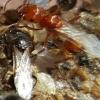Hi all, my name is Amanda and I'm a UCR Phd student new to entomology and ants in general. Does any one have advice on how to keep workers alive for at least 8 weeks? I'm going to collect these species in Riverside, CA: Veromessor pergandei, Tapinoma sessile, Formica francoeuri, and Solenopsis
xyloni. I will try to collect a Polyergus breviceps colony if it has any slave species, but it looks like it is rare in southern California.
For my project, I have to keep their diet and enclosure as similar as possible, if not identical. Any advice would be greatly appreciated!





















